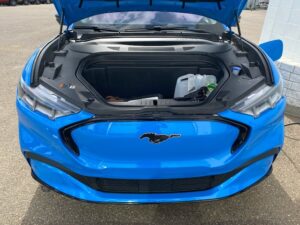Mustang Mach-E owner, Dennis Brochu, kindly stopped by Zarowny Motors to give us his insight into owning and driving an electric vehicle in rural Alberta. Dennis works in the Bonnyville area, staying locally during these shifts and in his off time, driving to his home-base in Moose Jaw, Saskatchewan. This translates into about 4,000 km per month in highway driving for Dennis, hitting his pocket book in fuel expenses hard. It was this large expense that initiated Dennis’ research into buying an electric vehicle.
One important factor in Dennis’ decision to work with Zarowny Motors was having access to local sales and service support. It made no sense to him to add additional driving time to Edmonton or Calgary, especially since his previous vehicle purchases (Ford Focus and F150) had been with Zarowny Motors and he was extremely happy with those experiences. And while electric vehicles now come in several makes and models, the Mustang Mach-E was the one for Dennis. Who doesn’t want to own a Mustang?
Switching to an electric vehicle (EV) has made a huge impact on Dennis’ expenses. Since owning his Mach-E since the beginning of April, Dennis has had $360 of vehicle expenses for public charging fees. That’s it! In comparison, over the same three-month period he estimates that with his previous Ford Focus and F150 he would have spent $2100 and $3600 respectively. And this estimate was prior to the current high fuel costs!
Given the distance that Dennis is regularly driving, we wanted to know the logistic challenges of charging his Mach-E across the prairies. Dennis was quick to point out that the Mach-E’s navigation system, as well as the FordPass app, map all Ford charging locations. Dennis also accesses third party aps for additional charging stations at service stations and local municipalities. Together with Zarowny Motors, Dennis has also learned the Mach-E’s charging speeds via charging types. For example, a DC fast charge station takes about 40 minutes to charge the Mach-E battery from 0 to 80%. A Level 2 charging station is more of an overnight charge. Dennis also calculates 480 km per full charge. On a recent trip to Winnipeg, Dennis stopped 4 times to charge. In total, this added only one hour to his trip as he mapped fast charging stations that took minimum stop times.
Besides the fuel savings, Dennis is enjoying the reduced maintenance time of his Mach-E versus a traditional gas engine, especially with his busy lifestyle. The Mach-E battery recommendation for normal day driving is a base rate no lower than 20% to a charge top rate of 90% which reduces the wear of the battery. It is also recommended that on longer trips the battery be charged to 100%. Be aware that the battery has its own coolant system. Other general maintenance items are the usual tire rotations and interior air filter.
Bonus features on the Mach-E include the front boot area (space freed up without a gas engine) that is an insulated cooler space complete with a drain, spacious rear trunk and extra-large display screen. All in all, Dennis is extremely happy with his choice of the Mustang Mach-E. It gives him great savings and in a style that he rocks!


